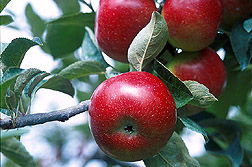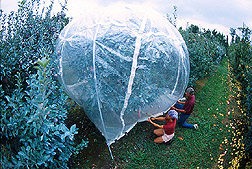Whitewashing Agriculture
|
||
|
Last year, Michael Glenn held the Big Apple in the palm of his hand . . . and he was far from New York City.
In the orchards of ARS' Appalachian Fruit Research Station in Kearneysville, West Virginia, the severe drought of 1999 revealed another advantage of covering apple and pear trees with a white, reflective film of specially processed kaolin, a type of clay. Empire apples harvested from treated trees were an average of 17 percent larger than fruit from trees left naked to withstand the heat—even from trees that were irrigated. And there was no decline in the number of apples. Sekel pears reacted a little differently. The protected trees yielded twice as many pears as the naked trees—with no loss in fruit size, says Glenn, a soil scientist and plant physiologist. |
|
|
On the West Coast, the stark-white particle film, now sold under the trade name Surround WP, prevents sunburn on apples and walnuts, he adds.
Yes, fruit can suffer sunburn too, and the damaged areas are perfect places for rot organisms to multiply. So packers pay bottom dollar for produce with blemished skin or shells, or they reject it altogether. In studies here and in South America, South Africa, Australia, and New Zealand "the kaolin-based product has cut sunburn damage on apples in half," Glenn says. That reduction gives growers an economic advantage, says Jim McFerson, manager of the Washington Tree Fruit Research Commission. He notes that several Washington apple growers are using kaolin to prevent sunburn alone. In his collaborative studies with Glenn, the coating has not increased tree vigor or yield nor improved the color of the state's apples as it has in the East. |
|
|
|
Cooler Crops
As nomads crossing the desert wear white robes to reflect the sun's rays, trees wearing the specially processed kaolin coat reflect the heat-producing infrared wavelengths, as well as the burning ultraviolet rays. In fact, it's the ability to keep the tree cooler under a blazing sun that increases yield. "The reflective kaolin helps to improve the tree's environment by reducing leaf temperature and heat stress," explains Glenn. As a result, the leaves keep their tiny portals—stomates—open, allowing more carbon dioxide to enter. This gives the leaves more raw material to photosynthesize into food for the tree. "The tree doesn't have to abort as much fruit, and there's more carbon for its own growth and maintenance," explains Glenn. The result: a healthier, happier tree that can support higher yields year after year. |
|
|
In the Kearneysville orchards last summer, kaolin-coated trees photosynthesized up to 30 percent faster than uncoated trees, says Glenn. He measures the rate of photosynthesis by covering the whole tree with a clear balloon through which he forces air with a fan. His instruments read how much carbon dioxide enters the balloon at the bottom and how much exits the top. The difference is a measure of photosynthesis.
A multiyear drought ongoing in Israel has parched farmland, forcing the country to import fresh water from Turkey for irrigation. So Israeli horticulturist Amnon Erez, who recently retired from the Volcani Center in Bet-Dagan, spent 4 months in Kearneysville last year learning about the film's stress-reducing potential. Now back in Israel, Erez is overseeing a wide range of crop studies to demonstrate Surround's ability to help plants and trees thrive under extreme heat and water stress. "He had never seen anything that affects a tree's microclimate as much as Surround does," says Peter Barrows, project manager with Surround's producer, Engelhard Corporation of Iselin, New Jersey. Robin Matson, western field representative for Engelhard, says Surround improves color and raises the sugar content of Arizona-grown lemons, while preventing the trees from shutting down under the hot temperatures common in the Southwest. And Surround-coated grapes reach the desirable sugar content—known as brix—a little sooner than those left bare. |
|
|
|
It All Began . . .
About 8 years ago, while looking for a way to reduce the use of synthetic chemicals in orchards, Glenn conceived of using kaolin particles as a physical barrier that would repel insects and prevent disease organisms from digging in. He approached Engelhard, one of the largest producers of kaolin, about doing cooperative research. Among its many uses, kaolin gives paper its whiteness and is used in paint, pottery, and cosmetics. And it's safe to ingest. A tiny bit of kaolin is already in aspirin and some other tablets. (See "Particle Films: A New Kind of Plant Protectant,"Agricultural Research, November 1998, pp. 16-19.) But agricultural uses were uncharted waters. Early studies by Glenn and ARS entomologist Gary J. Puterka showed that the physical barrier controlled insect damage well. The type of kaolin Glenn had selected for the studies transmitted visible light and gases necessary for photosynthesis while reflecting ultraviolet and infrared bands. But the film was difficult to spray on the trees because it didn't suspend in water. So Engelhard, under a cooperative research and development agreement with ARS, removed the waterproofing additive, improving kaolin's ability to mix with water. What's more, leaving out the additive dramatically cut the cost of the product. That started what may prove to be one of the most versatile agricultural products ever to hit the market (see box on page 17). Surround Crop Protectant went commercial in 1999. This year it was upgraded to a wettable powder formulation called Surround WP Crop Protectant. Barrows says Engelhard priced the product to compete with insecticides. Since it is a physical barrier, it must be reapplied to cover new growth or after a heavy rain, he says. The cost of three to four applications of Surround is about equal to one application of the insecticide pear growers use against pear psylla. It was this tiny but devastating insect that boosted Surround commercially last year. "We had intended to have a year of trial usage," says Barrows. But entomologists found pockets of insecticide resistance. "When it became known that Surround controlled pear psylla as well as it does, we had to make and ship a lot more than we anticipated." Glenn stresses that "specially formulated kaolin has the potential to greatly reduce pesticide use on conventionally grown crops. The Organic Materials Review Institute has listed Surround WP for organic food production." Insects Don't Like Biting the Dust After several years of testing, the product is proving its prowess against all shapes and sizes of insects. The white leaves keep insects from recognizing their favorite hosts, and the tiny particles ensure a lack of hospitality. Just as people don't like climbing into a bed full of sand, insects don't like crawling on a plant or tree covered with kaolin. It sticks to their wings, legs, and mouth parts, so they quickly leave to find a more comfortable place to feed and lay eggs. In studies around the country, codling moths, apple maggots, plum curculio, leafhoppers, Japanese beetles, rose chafer, thrips, and rust mites—not to mention pear psylla—have fled whitewashed crops in search of greener pastures. Even glassy-winged sharpshooters—the transmitter of Pierce's disease, which threatens to devastate southern California's grape vineyards—avoid kaolin-treated lemon trees. And early results suggest they'll stay away from treated grapevines too. ARS' Puterka says the specially formulated kaolin particles "have the potential to work against almost any insect. The key is getting good coverage of the crop. If you can get it to stick and stay, it will control most insects." One crop that has failed the stick test is cabbage, so Surround doesn't control cabbage loopers and other worms. And because it's eventually washed off all crops by rain, areas of low rainfall are most adaptable to this technology, Puterka adds. Don Gallagher of Gallagher Vineyards in Manteca, California, was pleased with the early results of Surround on 12 of his 57 rows of grapes. "When I put it on, there were a lot of mealybugs on the vines. But I can't find one of them now. I don't know where they've gone." Gallagher did, however, find a couple of mealybugs on insecticide-treated vines, he says, noting that he's finding a similar pattern for leafhoppers on the crop. Jay Brunner, professor of entomology at Washington State University in Wenatchee, is looking at Surround's clout against insect pests of the state's apple orchards. His results have been mixed. "It's as good as many selective insecticides for controllingLacanobia fruit worms and leafrollers," he says. But it proved only fair for codling moths and variable for stinkbugs. Plus, it seems to interfere with helpful parasitic insects that hang around the orchard and keep leafminers under control, Brunner adds. In insect control, as in comedy, timing is everything. So Brunner and other entomologists are working to determine the optimum timing and application rates to control specific pests without disrupting the biological control of others. "I think Surround will have a place in certain pest-management programs where growers are trying to avoid pesticides," says Brunner. Todd DeKryger, agricultural research specialist with Gerber Products Company in Fremont, Michigan, sees potential for Surround to fit in with conventional methods to control specific pests on specific crops. "It eliminates residues of conventional pesticides and helps us maintain a stable supply of produce," says DeKryger. This year, Gerber growers are trying it on pears, apples, peaches, and carrots. DeKryger says it appears to work better in the dry West because more of the film stays on the foliage. "The jury's still out on its feasibility east of the Rockies," he says, noting that May 2000 was the wettest May on record in Michigan. Fungi Dodge It, Too While the potential for insect control got brighter, the outlook for controlling orchard diseases didn't look very promising . . . until last summer. After some trial and error, Glenn believes he has hit on the right formula by adding other minerals to Surround. The minerals make the film more alkaline (raise the pH), he says, and that seems to prevent fungi from taking hold. In the middle of July, Glenn's untreated apple leaves were contorted under the stress of powdery mildew infection. Not so with the treated trees. Leaves lay flat and looked healthy. And 90 to 95 percent of the fruit were disease free. The mixture also controlled apple scab. "We still get the same insect control," says Glenn. "The mineral combination adds a new dimension." And That's Only the Beginning Uses for kaolin films don't end here. Glenn and Puterka also see kaolin's potential as a carrier for just about any chemical used on the farm—pesticide, fungicide, herbicide, pheromone—you name it. "It can be used as a matrix to hold chemicals on the plant or soil and get more even distribution," Puterka says. Such improved delivery would benefit the environment, farm workers, and consumers. "You may be able to reduce the active ingredient by 50 percent or more," he says. The latest patent application jointly filed by ARS and Engelhard covers this use of kaolin. A water-repelling kaolin formula may have other applications. Tests show that this hydrophobic film protects tender plants and trees from frost damage. Normally, when the temperature drops below freezing, ice crystals forming on a wet leaf penetrate the surface and freeze the leaf tissue. Frost damage can cost U.S. growers hundreds of millions of dollars annually. But the waterproof kaolin keeps water from direct contact with the leaf surface. And it makes water bead up, which further reduces the surface area of the droplet resting on the leaf, says ARS' Michael E. Wisniewski, a plant physiologist at Kearneysville. In his tests in environmental chambers, kaolin-treated tomato and bean plants have withstood temperatures as low as 21°F (-6°C). They normally die when the thermometer drops to 28°F (-2°C). Wisniewski says Mick Fuller, professor of horticulture at the University of Plymouth in England, is getting similar results on citrus, potato, and grape plants in his environmental chambers. "His findings are particularly impressive for citrus," he adds. In addition, other researchers are beginning to look at the potential of kaolin-based products to address several other needs—agricultural and otherwise. Kaolin's agricultural uses "have opened a whole new area of science," says Puterka. So far, they have spawned four patents jointly owned by ARS and Engelhard Corporation, and five more patent applications are either pending or being prepared.—By Judy McBride, Agricultural Research Service Information Staff. This research is part of Crop Protection and Quarantine, an ARS National Program (#304) described on the World Wide Web at http://www.nps.ars.usda.gov. D. Michael Glenn, Gary J. Puterka, and Michael E. Wisniewski are at the USDA-ARS Appalachian Fruit Research Station, 45 Wiltshire Rd., Kearneysville, WV 25430-9423; phone (304) 725-3451, ext. 321 [Glenn], ext. 361 [Puterka], ext. 320 [Wisniewski], fax (304) 728-2340. The Versatile Horticultural Coating: Proven and Potential Uses: Field tests show that kaolin can:
|
|
|
"Whitewashing Agriculture" was published in the November 2000 issue of Agricultural Research magazine. |
||











